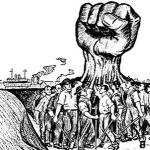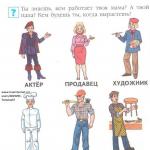When water from an overturned glass spills on the floor or when we blow a soap bubble, the surface of the liquid increases. In this case, new areas of the rarefied surface layer appear. The average distance between molecules when they move from the depth of a liquid to its surface increases. The forces of attraction between the molecules of the liquid do negative work. In accordance with the laws of mechanics, this means an increase in the potential energy of molecules moving from the depths of the liquid to the surface.
The molecules of the surface layer of a liquid have an excess of potential energy compared to the energy that these molecules would have if they were inside the liquid.
The excess potential energy possessed by molecules on the surface of a liquid is called surface energy.
From a macroscopic (thermodynamic) point of view, surface energy is one of the types internal energy, absent in gases, but present in liquids*.
*Solid bodies also have surface energy. After all special conditions, in which molecules are located on the surface of a liquid, are also characteristic of the surface of solids.
When water spreads from an overturned glass on the floor, the energy of the surface layer molecules increases due to the work of gravity. And when blowing a soap bubble, the potential energy of the surface layer molecules increases due to the work of air pressure forces in the bubble. After all, in order for a bubble to inflate, the air pressure in it must be greater than atmospheric pressure.
Surface tension
Molecules in all areas of the surface layer of a liquid are in the same conditions, and two areas of the same area have the same surface energy. It means that surface energy is directly proportional to the surface area of the liquid. Therefore, the surface energy ratio U n section of the surface of the liquid to the area S of this section is a constant value that does not depend on the area S. This quantity is called the surface tension coefficient or simply surface tension and is denoted by the letter σ:
Surface tension is specific surface energy, i.e., the energy per unit surface area.
In SI, surface tension is expressed in joules per square meter(J/m2). Since 1 J = 1 N m, surface tension can be expressed in newtons per meter (N/m).
Surface tension a depends on the nature of the surrounding media and on temperature. As the temperature increases, the difference between the liquid and its saturated steam gradually wears off and critical temperature disappears completely. Accordingly, the surface tension for the liquid-saturated vapor interface decreases with increasing temperature and becomes equal to zero at the critical temperature.
From formula (7.3.1) it follows that
 (7.3.2)
(7.3.2)
Therefore, as the surface area decreases, the surface energy decreases. In this case, molecular forces perform positive work, since the distances between molecules decrease when they move from the surface layer into the depths of the liquid. In a state of fluid equilibrium, the surface energy has a minimum value. This corresponds to the minimum surface area for a given volume. Therefore, as discussed in § 7.1, a liquid takes the shape of a sphere if there are no other forces distorting its natural spherical shape.
The surface layer of a liquid stores energy directly proportional to the surface area. Surface energy- one of the forms of internal energy.
On the surface of a liquid, near the boundary separating the liquid and its vapor, the interaction between the molecules of the liquid differs from the interaction of molecules inside the volume of the liquid. To illustrate this statement, consider Fig. 20 .
Rice. 20. Interaction between molecules inside and on the surface of a liquid
Molecule 1, surrounded on all sides by other molecules of the same liquid, experiences on average the same attraction to all its neighbors. The resultant of these forces is close to zero. Molecule 2 experiences less upward attraction from the vapor molecules and greater downward attraction from the liquid molecules. As a result, molecules located in the surface layer are acted upon by a downward-directed resultant force R, which is usually referred to per unit area of the surface layer.
To transfer molecules from the depths of a liquid to its surface layer, it is necessary to do work to overcome the force R. This work goes to increase the surface energy, i.e. the excess potential energy possessed by molecules in the surface layer compared to their potential energy inside the rest of the liquid.
Let us denote by W s the potential energy of one molecule in the surface layer, W v - the potential energy of a molecule in the volume of liquid, N - the number of molecules in the surface layer of liquid. Then the surface energy is equal to:
W surface =(W s -W v) N (75)
The surface tension coefficient (or simply surface tension) of a liquid is the change in surface energy with an isothermal increase in surface area by one unit:
σ=ΔW surface /ΔS=(N/S)·(W s -W v)=n·(W s -W v) (76)
Where n is the number of molecules per unit surface area of the liquid.
If the surface of the liquid is limited by the wetting perimeter, then the surface tension coefficient is numerically equal to force, acting per unit length of the wetting perimeter and directed perpendicular to this perimeter:
Where l is the length of the wetting perimeter, F is the surface tension force acting on the length l of the wetting perimeter. The force of surface tension lies in a plane tangent to the surface of the liquid.
Reducing the surface area of a liquid reduces surface energy. The condition for stable equilibrium of a liquid, like any body, is a minimum of potential surface energy. This means that in the absence of external forces, the liquid should have, for a given volume smallest area surfaces. Such a surface is a spherical surface.
As the temperature of the liquid increases and it approaches the critical value, the surface tension coefficient tends to zero. Far from Tcr, the coefficient σ decreases linearly with increasing temperature. To reduce the surface tension of a liquid, special impurities (surfactants) are added to it, which are located on the surface and reduce the surface energy. These include soap and others detergents, fatty acids, etc.
Did you know, What is the falsity of the concept of “physical vacuum”?
Physical vacuum - the concept of relativistic quantum physics, by which they mean the lowest (ground) energy state of a quantized field, which has zero momentum, angular momentum and other quantum numbers. Relativistic theorists call a physical vacuum a space completely devoid of matter, filled with an unmeasurable, and therefore only imaginary, field. Such a state, according to relativists, is not an absolute void, but a space filled with some phantom (virtual) particles. Relativistic quantum field theory states that, in accordance with the Heisenberg uncertainty principle, virtual, that is, apparent (apparent to whom?), particles are constantly born and disappeared in the physical vacuum: so-called zero-point field oscillations occur. Virtual particles of the physical vacuum, and therefore itself, by definition, do not have a reference system, since otherwise Einstein’s principle of relativity, on which the theory of relativity is based, would be violated (that is, an absolute measurement system with reference to the particles of the physical vacuum would become possible, which in turn would clearly refute the principle of relativity on which the SRT is based). Thus, the physical vacuum and its particles are not elements of the physical world, but only elements of the theory of relativity, which do not exist in the real world, but only in relativistic formulas, while violating the principle of causality (they appear and disappear without cause), the principle of objectivity (virtual particles can be considered, depending on the desire of the theorist, either existing or non-existent), the principle of factual measurability (not observable, do not have their own ISO).
When one or another physicist uses the concept of “physical vacuum,” he either does not understand the absurdity of this term, or is disingenuous, being a hidden or overt adherent of relativistic ideology.
The easiest way to understand the absurdity of this concept is to turn to the origins of its occurrence. It was born by Paul Dirac in the 1930s, when it became clear that denying the ether in its pure form, as was done by a great mathematician but a mediocre physicist, was no longer possible. There are too many facts that contradict this.
To defend relativism, Paul Dirac introduced the aphysical and illogical concept of negative energy, and then the existence of a “sea” of two energies compensating each other in a vacuum - positive and negative, as well as a “sea” of particles compensating each other - virtual (that is, apparent) electrons and positrons in a vacuum.
Molecules in a liquid have kinetic energy of thermal motion and potential energy of intermolecular interaction. To move a molecule from the depth of a liquid to the surface, work must be done to overcome the force of molecular pressure. This work is done by the molecule due to the reserve of kinetic energy and goes to increase its potential energy. Therefore, the molecules of the surface layer have additional potential energy compared to the molecules inside the liquid. This additional potential energy possessed by the surface layer molecules is called surface energy.
If the surface of a liquid is stretched, more and more molecules will come to the surface, and the potential energy of the surface layer will increase. Consequently, the surface energy is proportional to the area of the liquid surface itself (Fig. 4).
Where A– work of surface tension force; F– surface tension force; D x– film stretching; D S– change in the surface area of the film.
From this expression we can give another definition of the surface tension coefficient.
The surface tension coefficient is equal to the free surface energy per unit surface area. In this case, the unit of measurement is [a] = [J/m 2 ].
The impurities in the liquid have a great influence on the surface tension. For example, soap dissolved in water reduces the surface tension coefficient to 0.045 N/m, while sugar or salt increases it. Substances that change surface tension are called superficially active. These include oil, soap, alcohol. This phenomenon is explained by intermolecular interaction between molecules. If the interaction between the molecules of the liquid itself is greater than between the molecules of the liquid and the impurity, then the impurity molecules are pushed to the surface and the concentration of the impurity on the surface is greater; than in volume, which leads to a decrease in surface tension.
Surfactants are widely used when cutting metals, drilling rocks, etc., since the destruction of rocks in their presence occurs more easily, adsorbed on the surface of a solid, they penetrate into microcracks and contribute to further development these cracks deep down.
Surface tension of a liquid.
Surface layer of liquid.
All liquids and solids limited by the outer surface at which they come into contact with phases of a different composition and structure, for example, with steam, another liquid or solid.
Properties of matter in this interfacial surface, several diameters of atoms or molecules thick, differ from the properties inside the phase volume.
Inside the volume of a pure substance in a solid, liquid or gaseous state, any molecule is surrounded by similar molecules.
In the boundary layer, molecules are in interaction with another number of molecules (different in comparison with the interaction inside the volume of the substance). This happens, for example, at the interface of a liquid with its vapor.
The average value of the resultant molecular forces of attraction applied to a molecule located inside a liquid is close to zero. In the figure below this molecule is labeled M1.
Random fluctuations of this resultant cause the molecule M1 perform only chaotic movement within the liquid.
The situation is different with molecules located in the surface layer of liquid.
Consider a molecule located directly at the interface. In the figure we denote it M2.
If there are molecules around M2 describe the sphere of molecular action, then inside this sphere there will be centers of many other molecules that will interact with our molecule. The radius of such a sphere is approximately 10 -9 m.
For a molecule M2 in the lower hemisphere there will be many molecules, and in the upper hemisphere there will be much less, since there is liquid below and steam or air above.
Therefore for a molecule M2 resultant of molecular forces of attraction in the lower hemisphere much more resultant of molecular forces in the upper hemisphere. The forces acting in the upper hemisphere are so small that they can be neglected.
If we consider another molecule, which, in comparison with M2 will be a little more “recessed” into the liquid, but also located in the surface layer. Let's denote it M3.
Since in the upper hemisphere M3 there will be other liquid molecules, they will attract M3 towards itself and partially balance the forces of attraction of molecules located in the lower hemisphere M3.
As a result, the total resultant of the forces acting on M3 will be less than the total resultant M2.
Both resultants will be directed into the liquid perpendicular to its surface.
Thus, all molecules of the liquid located in the surface layer with a thickness equal to the radius of molecular action are drawn into the liquid.
But the space inside the liquid is occupied by other molecules, so the surface layer creates pressure on the liquid, which is called molecular pressure.
Energy of the surface layer of a liquid.
Since the molecules of a liquid located in its surface layer are drawn into the liquid, their potential energy is greater than that of the molecules inside the liquid.
This additional potential energy of the molecules of the surface layer of the liquid is called free energy. Due to it, work can be done associated with a decrease in the free surface of the liquid.
And, conversely, in order to bring the molecules located inside the liquid to its surface, it is necessary to overcome the opposition of molecular forces, i.e. produce the work needed to increase the free energy of the surface layer of the liquid.
In this case, the change in free energy is directly proportional to the change in the surface area of the liquid.
Since any system spontaneously transitions into a state in which its potential energy is minimal, the liquid must spontaneously transition into a state in which its free surface area has the smallest value.
For example, a drop of rain or fog in the air takes on the shape of a ball, a shape corresponding to the lowest level of free energy.
Surface tension coefficient
Surface tension coefficient- this is a quantity that characterizes the dependence of the work of molecular forces going on to change the area of the free surface of a liquid and the area of change of this surface itself.
σ = А/ΔS
σ - surface tension coefficient
A– the work of molecular forces to change the surface area of a liquid
ΔS- change in liquid surface area
σ measured by the work done by molecular forces when the free surface area of a liquid decreases by one.
The surface tension coefficient depends on the type of liquid and external conditions, for example, temperature.
Molecule M1, which is located on the surface of the liquid, interacts not only with the molecules located inside the liquid, but also with molecules on the surface of the liquid located within the sphere of molecular action.

For a molecule M1 resultant R molecular forces directed along the surface of the liquid is zero, and for a molecule M2, located at the edge of the surface, R is different from zero.
From the figure it can be seen that the force R directed perpendicular to the boundary of the free surface and tangential to the surface itself.
Molecular forces directed along the surface of a liquid act on any closed line on the free surface of the liquid normal to this line in such a way that they tend to reduce the surface area of the liquid limited by the closed line.
This can be shown in the following experiment.
A thread of length is attached to a wire ring L.

If you tighten the ring with soap film, then the thread will rest freely on this film(Figure A). The surface area of the soap film will be determined by the contour of the frame.
If you break through the soap film from the underside of the thread, then molecular forces will reduce the surface, now limited by the upper part of the contour and the thread. Wherein the thread will stretch(Fig. B).
The force caused by the interaction of liquid molecules, causing a reduction in the area of its free surface and directed tangentially to this surface, is called surface tension force.
Molecular Pressure Forces draw molecules from the surface into the liquid and reduce the free surface area, i.e. close the formed “windows” on this surface.
So, the surface layer of a liquid is always in a state of tension. However, this state cannot be compared with the tension of an elastic stretched film. Elastic forces increase as the area of the stretched film increases, and surface tension forces do not depend on the surface area of the liquid.
Experience shows that surface tension coefficient influenced by the environment and temperature of the liquid. As the temperature of the liquid increases, it surface tension decreases and becomes zero at the critical temperature.




